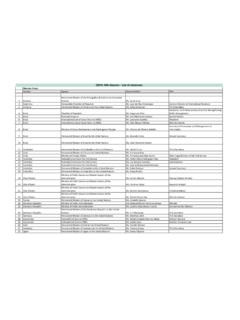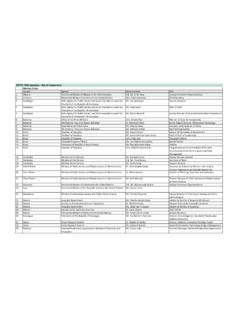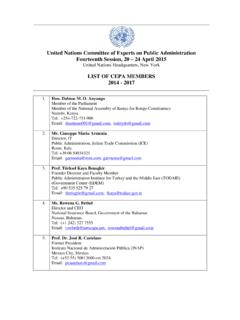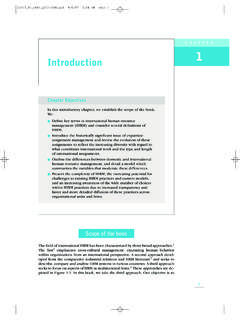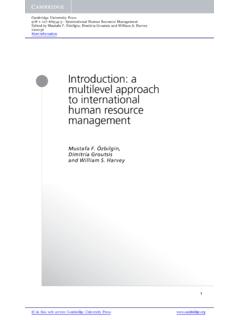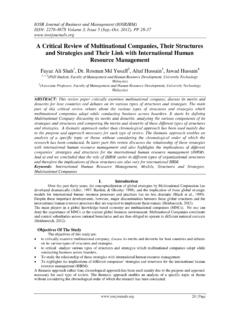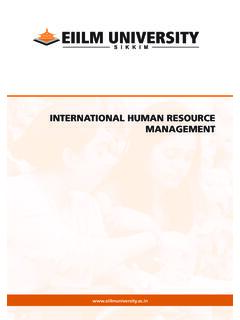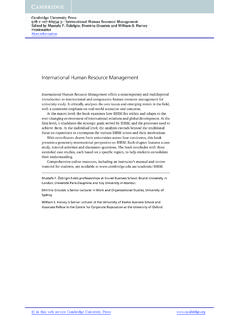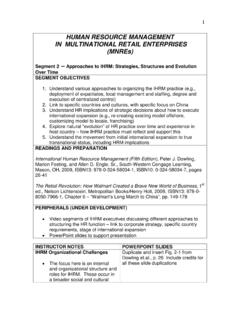Transcription of International Human Resource Management: …
1 FACULTY OF BUSINESS AND ECONOMICS I S S N 1 3 2 7 5 2 1 6 Abstract Over the last two decades there has been an unprecedented increase in the number of organisations that have internationalised their operations, assisted and encouraged to do so by the removal of national protectionist trade policies, de-regulation of International fiscal and monetary markets, and rapid advances in communications and distribution channels. The International movement of labour that has been concomitant with such expansion of International business has meant that issues associated with the management of Human resources across International borders have become of increasing importance to International Human Resource managers and academics.
2 The research on which this paper is based examines the pedagogy and practice of IHRM in Australia and shares knowledge about critical developments within this field. It reports International Human Resource management (IHRM) scholars and practitioners understanding of the major issues for teaching and practice in IHRM and elucidates current and future issues challenging this field. This paper is a work in progress. Material in the paper cannot be used without permission of the author.
3 International Human Resource management : challenges FOR TEACHING AND PRACTICE Helen De Cieri, Marilyn Fenwick & Kate Hutchings Working Paper 59/03 August 2003 1D E P A R T M E N T O F M A N A G E M E N T International Human Resource management : challenges FOR TEACHING AND PRACTICE INTRODUCTION During the last two decades academicians and practitioners of International management have paid increasing attention to the impact of globalisation on the management of Human resources across national boundaries.
4 Just as International businesses have turned their attention to issues such as expatriate management , managing in other cultures, working with impatriates and managing diversity in multicultural domestic workforces, so too have academicians advanced understanding in these areas through the development of a distinct sub-field within the management discipline, namely International Human Resource management (IHRM). As more markets internationalise, more nations become integrated into the International world economy, and more businesses choose to expand their operations across national borders, issues around the people management and career development of both International managers and those they manage in International operations, becomes more critical to the International strategic planning and operations of firms.
5 As this occurs, the importance of IHRM as a field of academic endeavour is becoming more pronounced. We suggest that for the field of IHRM to develop, both practically and pedagogically, it is critical that knowledge is shared and different perspectives of IHRM academicians, educators and practitioners made known. However, knowledge sharing is not automatic and strategies to achieve it are not clearly elucidated by either academicians or practitioners. It seems that in the management /organisational behaviour (M/OB) field, from which HRM and IHRM evolved, knowledge sharing between academicians and practitioners cannot by any means be a taken-for-granted assumption.
6 Concern about a gap between academic research, the basis for pedagogy, and management practice is not new. Rynes, Bartunek and Daft (2001), recent guest co-editors for a special research forum titled, Knowledge transfer between academics and practitioners for the Academy of management Journal, report a crisis in the field of organizational science . Its main symptom is that the more sophisticated our research technology has become, the less useful it has been seen for solving their organisational problems by practitioners.
7 They note [o]bservers have long noted a considerable gap between organizational research findings and management practices (2001: 340). The co-editors introduction to the research forum provides evidence of the pervasiveness of a management research-practice gap. They further comment that others have shown managers typically do not use academic research or academic research findings when developing their management practices. Moreover, when organisations agree to participate in academic research projects, generally they are not interested in perusing the results of survey/interview data made available to them by the academicians at the completion of the data collection phase or the project overall.
8 Instances where researchers consult with practitioners when formulating their research questions are also rare, according to Rynes and Trank (1999). Practitioners perceive research results to be useful according to the degree to which they can interpret them, and when they are designed collaboratively and in context. Mohrman, Gibson and Mohrman s (2001) findings indicated practitioners found research results most useful when they are jointly interpreted with researchers and are informative to self-design activities.
9 Mohrman et al. (2001: 369) define self-design as those actions and cognitive processes that individuals use to reorganise and redesign their organisations in accordance with the dynamism of organisational environments. In 1989, Cyn D Fisher wrote that a practicing HR manager lamented the fact that International HR managers are working in an information void and needed support from academics through research and courses in International HRM (Fisher, 1989:160). At the time she also noted that conceptual papers were beginning to appear, and some empirical research on strategic HRM had been reported.
10 However, she suggested that a research-practice gap clearly existed, with research lagging behind the current needs of practicing HR executives. Moreover, she claimed that the state of practice in most organisations lagged far behind the state of knowledge (Fisher, 1989:174). Further, despite past investigations into the gap between the normative recommendations of organizational researchers (Rynes et al., 2001: 340) and management practices, it appears that there has been no attempt to investigate the existence, nature and extent of any such gap in the specific genre of IHRM, some 14 years after Fisher s (1989) article.




